
Pears are fruits produced and consumed around the world, growing on a tree and harvested in the Northern Hemisphere in late summer into October. The pear tree and shrub are a species of genus Pyrus, in the family Rosaceae, bearing the pomaceous fruit of the same name. Several species of pears are valued for their edible fruit and juices, while others are cultivated as trees.
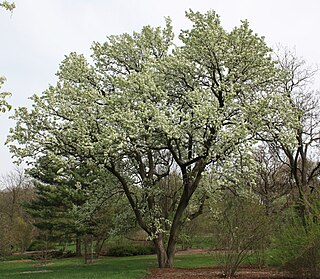
Pyrus calleryana, or the Callery pear, is a species of pear tree native to China and Vietnam, in the family Rosaceae. It is most commonly known for its cultivar 'Bradford', widely planted throughout the United States and increasingly regarded as an invasive species.

Pyrus communis, known as the common pear, is a species of pear native to West Asia, central and eastern Europe.

Pyrus salicifolia is a species of pear, native to the Middle East. It is widely grown as an ornamental tree, almost always as a pendulous cultivar, and is called by various common names, including willow-leaved pear, weeping pear, and similar. The tree is deciduous and of comparatively small stature, rarely reaching 10–12 meters in height. The crown is rounded. It has pendulous, silvery foliage, superficially similar to a weeping willow. The flowers are large and pure white highlighted with black-tipped stamens although the buds are tipped with red. The small green fruits are inedible, being hard and astringent.

Malus sieversii is a wild apple native to the mountains of Central Asia in southern Kazakhstan. It has recently been shown to be the primary ancestor of most cultivars of the domesticated apple. It was first described in 1833 by Carl Friedrich von Ledebour, a German naturalist who saw them growing in the Altai Mountains.
Pyrus anatolica is a species of plant in the family Rosaceae. It is endemic to Turkey.
Pyrus hakkiarica is a species of plant in the family Rosaceae. It is endemic to Turkey.
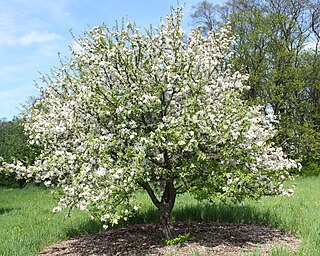
Malus prunifolia is a species of crabapple tree known by the common names plumleaf crab apple, plum-leaved apple, pear-leaf crabapple, Chinese apple and Chinese crabapple. It is native to China, and is grown elsewhere for use as an ornamental tree or as rootstock. It reaches from between 3 and 8 meters tall and bears white flowers and yellow or red fruit.

Officially Sochut Dendropark named after Edmund Leonowicz, commonly knowns as Stepanavan Dendropark, is an arboretum located near the Gyulagarak village, Lori Province, Armenia. Located around 85 km north of the capital Yerevan, the park was founded in 1931 by Polish engineer-forester Edmund Leonowicz. The arboretum is 35 ha in total of which 17.5 ha consist of natural forest and 15 ha of ornamental trees.
Pyrus boissieriana, the Boissier pear and telka, is a species of Pyrus (pear) native to the Kopet Dag region on the Turkmenistan and Iranian border. In its native locales it is cultivated as a rootstock for domestic pears.
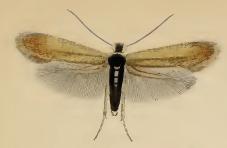
Stigmella minusculella is a moth of the family Nepticulidae. It is found from Denmark and Latvia to the Pyrenees, Corsica, Italy and Crete, and from Great Britain to Ukraine. It is also present in North America, where it is found in Ohio, New Jersey and Ontario.

Pyrus bourgaeana, the Iberian pear, is a close relative of Pyrus communis L. The last was domesticated about 2500 years ago. This monoecious small tree is widely distributed across the southern Iberian Peninsula and northern Morocco, where it coexists with four Pyrus species: P. communis L., P. cordata Dew., P. spinosa Forssk, and P. nivalis Jacq. Characteristics to discriminate these species are the width of fruit peduncle, petal size, leaf width and petiole length served to the taxa.
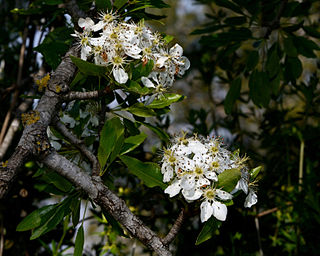
Pyrus syriaca is a deciduous tree in the Rosaceae family. It is referred to by the common name Syrian pear. It is the only pear species which grows in the wild in Lebanon, Turkey, Syria and Israel.

Pyrus amygdaliformis, also known as the almond-leaved pear, is a species of plant in the family Rosaceae. It is native to southern Europe, the Mediterranean, and west Asia. It grows to a height of 3–10 metres (9.8–32.8 ft). It has white flowers which bloom in April–May. The fruits are bitter and astringent. It hybridizes well with Pyrus communis and Pyrus pyraster.
Pyrus armeniacifolia, also known as the apricot-leaved pear, is a species of plant in the family Rosaceae. It is known from northern Xinjiang, where it is cultivated near Tacheng.
Lobesia virulenta is a moth of the family Tortricidae. It was described by Bae & Komai in 1991. It is found from northern Europe to Japan.
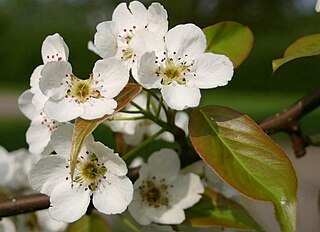
Pyrus ussuriensis, also known as the Ussurian pear, Harbin pear, and Manchurian pear, is a species of flowering plant in the family Rosaceae.
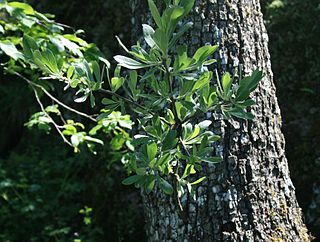
Pyrus elaeagrifolia, the oleaster-leafed pear, is a species of wild pear plant in the genus Pyrus (Rosaceae), the specific name referring to the similarity of its foliage to that of Elaeagnus angustifolia - the so-called 'wild olive' or oleaster.
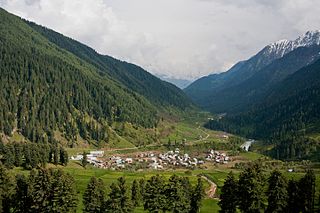
The Overa-Aru Wildlife Sanctuary is a protected area in Aru Valley near Pahalgam in Jammu and Kashmir, India. It is on the periphery of the two villages of Overa and Aru. The sanctuary spreads over 511 square kilometres (197 sq mi), lies 76 kilometres (47 mi) east of Srinagar. It was declared a game reserve in 1945 under the Dogra Rule and later upgraded to a sanctuary in 1981.

Pyrus korshinskyi, also known as the Kazak pear or Bukharan pear, is a wild species of pear tree native to Central Asia, including Afghanistan, Kyrgyzstan, Tajikistan, and Uzbekistan. The Kazak pear is in the genus Pyrus (Rosaceae). The IUCN categorises the pear as critically endangered, with it surviving in remote areas with threats including over grazing, harvesting, and use for rootstock. Genetically the pear has potential use for reducing the impact of disease on domesticated pears.














